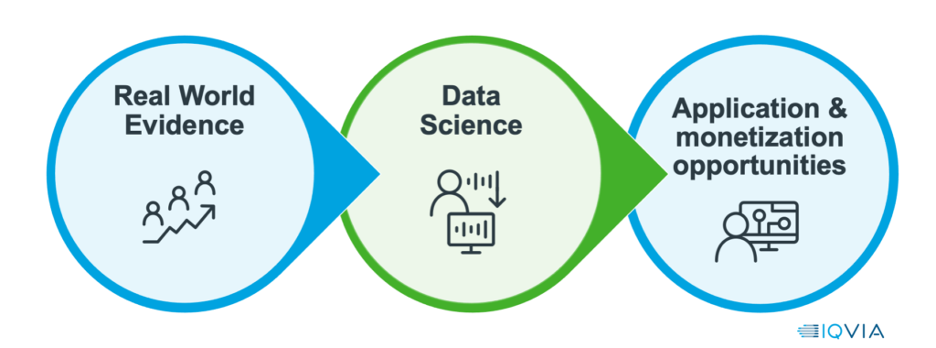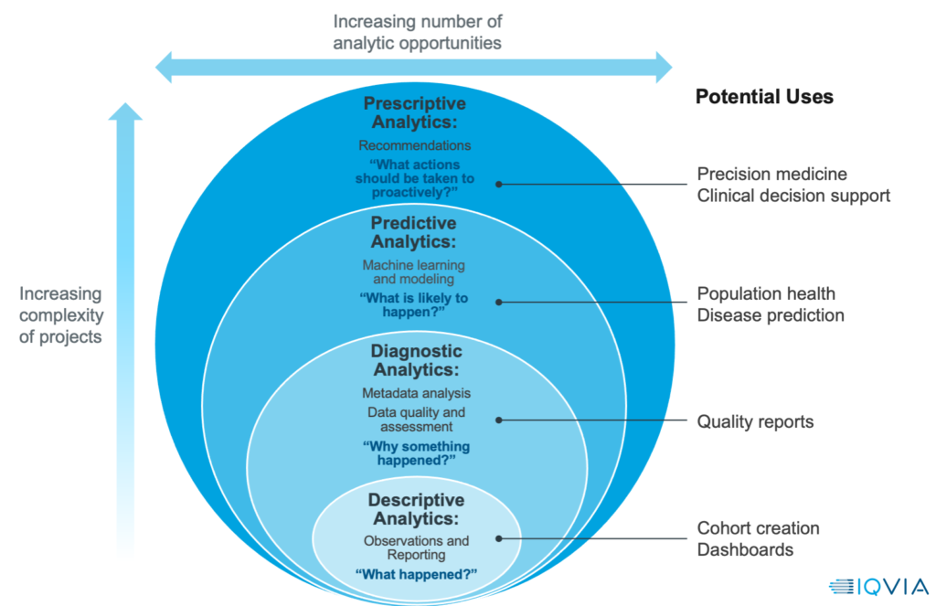















- Locations
- United States
- US Blogs
- Using Data Science to Unlock Insights from Your Healthcare Registry Data
Many not-for-profit organizations have health data programs or initiatives in place to support their mission activities and goals, and recognize the data is an asset that can be leveraged. Organizations would like to take advantage of advanced analytic tools to maximize the value of their data, however, it is challenging to know where to begin. For groups beginning their analytical journey, data science approaches and methods can appear daunting due to their complex, specialized nature. This blog is intended to orient and introduce basic types of analytic products that data science tools and methods can produce.
Introduction to data science
Data science is a field of work that combines computer science with statistics and subject matter expertise, with the goal of gleaning insights from data. Through a variety of statistical methods and big data analytic processes, organizations can focus on improving data quality, automating metrics and visualizations, and enabling downstream applications and monetization opportunities.
For not-for-profit organizations with registries, developing capabilities to expand their registry use is often an important goal. Patient advocacy organizations hope to use their data for research and publications or to increase awareness for their patient populations. Medical specialty societies, which include clinicians and practices, are increasingly focused on getting actionable insights to improve care and outcomes for their patients, so enabling organizations to expand their analytic capabilities is a necessary step when deciding areas to invest additional time and resources.

Investing in a large-scale project can be expensive, however, especially if the organization has little experience with running advanced analytics projects. It’s not easy to bootstrap new capabilities in this area and the competitive labor market doesn’t make it any easier—a not-for-profit may find it tough to staff a whole team of data scientists or analysts internally to work with the data. Standard registries are usually not optimized to support the complexity of healthcare data types, structures, and elements. Understanding the basic types of analytics and the insights that can be derived using these may help you develop a lower-risk strategy: start small and build up on successes.
Analytic products and their relationships
The figure below shows the relationship between different types of analytics and products with some examples of downstream use cases. Simple projects have relatively few types of analytic outputs. As projects get more complex, the range of possible analytic outputs also increases.

The simplest type of analytic work is descriptive analytics. Generally, this answers the question, “What happened?” in a dataset, and encompasses processes like basic data profiling, running statistical tests on a cohort, and often spans the smallest number of analytic product opportunities. Depending on the audience, results from descriptive analytics can be presented through visualizations or dashboards. These can be a great way to quickly disseminate information to a large audience.
The next level of analytics is diagnostic analytics. While descriptive analytics focus on what has happened, diagnostic analytics can begin to address why something has happened. Using diagnostic analytics, healthcare organizations can define some typical questions that arise with registry data to look for cause and effects in measures between sites or correlations between variables. Interestingly, insights about relationships between features can also be used to generate more sophisticated data quality reports and automate different types of quality checks in data.
In the next level, predictive analytics, historical data is used to train a model to predict what a future outcome or result will be; a common use of this type of analytic product is disease detection but it can be useful in predictions for many different scenarios depending on what the organization’s focus and questions are. The breadth of use cases is vast and depending on the robustness of available data, can be used to answer complex questions.
Finally, building on the predictive analytics tools are prescriptive analytics, which takes in a lot of the learnings and modeling from predictions and add a layer of information to develop recommendations, for example in the form of clinical decision support. Projects with prescriptive analytics span the largest number of possibilities, and robust datasets are once again a key component of developing accurate models. This type of work may require organizations to pull in the expertise of additional members of the technical team to put a model into production.
To fully utilize the newest analytic technologies and craft solutions for each organization, it’s necessary to have the right skill set and processes in place. We recommend starting with a needs assessment followed by a pilot to assess feasibility before investing in a full-scale data science project.
To learn more about our data science services, contact: pr-contact@iqvia.com
You might also be interested in this fact sheetHealthcare Non-profit Organizations Can Benefit from Acquiring New Types of Real-world Data
About the AuthorSonali Dasgupta, MS, Senior Data Scientist, Registry Center of Excellence, IQVIA Healthcare Solutions, Not-for-Profit
Sonali joined IQVIA Healthcare Solutions in 2020 to support the Registry Data Science team in developing analytical offerings for IQVIA’s Not-for-Profit clients. She works with patient advocacy organizations and medical specialty societies to develop custom data science projects while also developing reusable tools and services. Prior to IQVIA, Sonali worked in the pharmaceutical industry in preclinical drug development. She has a master’s degree in Pharmacology from University of Tennessee Health Sciences Center, and a bachelor’s degree in Biology and Psychology from Northwestern University. Sonali is currently based in San Francisco, California.




